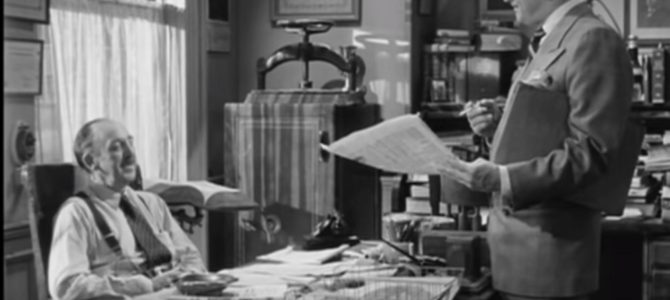
“Ace in the Hole” acts as evidence that no one could have predicted just how far journalism would slip over the past decade. The 1951 film starring Kirk Douglas offers a few good lessons for the media and its consumers, but the screenwriters couldn’t have known the problems social media journalism would create today.
The movie opens in Albuquerque as Chuck Tatum (Douglas) saunters into a small-town newsroom. He introduces himself to Boot, publisher of the Albuquerque Sun-Bulletin, explaining that he had fallen from grace in New York after a series of drunken incidents. Tatum tells Boot he needs just one sensational piece before the East Coast papers beg for him back.
(Spoilers ahead.)
A year later, Tatum has yet to find his big break, so Boot sends him to cover a rattlesnake hunt. Unhappy to cover such a menial event, Tatum obeys, but he never makes it to the hunt. Instead he pulls off the road to follow a patrol car with its sirens wailing. The sheriff’s deputy heads to a collapsed cave with a local man trapped inside, and Tatum decides he’s found his story.
Tatum hijacks the rescue project by convincing the contractor in charge to take a longer route. What should have taken 12 hours ends up taking six days, giving Tatum ample time to publish story after story about trapped Leo Minosa and his family. With every story Tatum publishes, Minosa gains more recognition. Families pile outside the cave to view the spectacle. By the end of the fourth day, 3,000 people surround the cavern, and New York offers Tatum his old job. But at what cost?
Tatum has little time to enjoy his success before the doctor diagnoses Minosa with pneumonia. The spelunker will survive only 12 hours if he doesn’t get to a hospital. Realizing the mistake he’s made, Tatum tries to reverse his actions. He tells the contractor to switch routes, but the shorter route is now impassible after five days of heavy drilling. Minosa has 12 hours to live, but the rescue won’t reach him for 24. Tatum takes his anger at the situation out on Minosa’s wife, who retaliates with a pair of scissors.
After Minosa’s death, Tatum finally sees the need to publish the full truth. He assigns a young reporter at the Sun-Bulletin to the task of revealing Tatum’s sins for the world to read. The movie closes as Tatum falls dead to the newsroom floor, suffering from the wound Minosa’s wife inflicted.
The film serves as an essay on the press’ morally inept tendencies and the public’s keenness to believe every word in print. While the major facts were true, Tatum failed to reveal the full story. He misled readers to believe a narrative that was convenient only to himself. His actions cost a man his life, but he paid for it in the end. Real-life journalism doesn’t have such a neat ending.
Journalists today don’t take the time to reroute the rescue efforts. They’re too lazy to manipulate the sheriff and the contractors. Were modern journalists in Tatum’s shoes, they wouldn’t miss a beat before publishing a sensational piece—they may not even take the time to interview Minosa before making up a story. Writer-director Billy Wilder filmed a movie meant to expose journalists who manipulate the truth, but he failed to foresee that journalists might eventually give up on truth altogether.
The media has allowed its fact-checking to fail— and even failed to bother fact-checking. Since the start of 2019, journalists have jumped to conclusions about Catholic teenagers, ignored clues that a supposed hate crime might be a hoax, and sunk back into the political gaslighting that arises every electoral season.
Media outlets have refused to take responsibility for the mistakes, pointing the blame at Twitter users who spread falsities. While they’re wrong to evade culpability, they make a good point. Social media acts as fire-starter for matchstick lies.
Online consumers care little about factuality. They just want to see information aligning with their own views. This, coupled with Twitter’s five-second attention span, fuels the media’s tendency to forego fact-checking. Journalists need to get the information into cyberspace before consumers hear it from a different source or stop caring.
“Ace in the Hole” serves not only as an essay on the press’ tendency towards false reporting, but it also serves as a warning against the public’s enthusiasm to believe what they read. After Tatum’s first article, spectators gathered to see the collapsed cave. Families parked campers and pitched tents outside, waiting for Minosa to come out alive. They eagerly drank in every word Tatum printed, never caring that it might not be the truth.
When Minosa passed, the onlookers fled faster than football fans flee after their team loses. They had nothing left to cheer for. In the end, consumers lost nothing more than a few days of their week. They never connected with Minosa because they never cared to learn the truth. They enjoyed the spectacle, and then they left.
Tatum was responsible for Minosa’s death, and the onlookers allowed him to commit the murder. Unfortunately, today’s journalists don’t have young Sun-Bulletin reporters to hold them accountable.









